Song Philyong
Painting the Spirit of Water
Interview by Jennis Kang.
A few years ago, I was impressed by waterfall paintings at an exhibition hosted by the Gwangju Museum of Art. When I viewed the vigorous waterfalls on the large canvases, I thought I could hear the sound of the water rushing down, and I felt chills. Inspired by this experience, I arranged to have an interview with the artist of “Flow,” Song Philyong, and got a chance to learn more about his artwork.
Jennis Kang (Jennis): I appreciate you giving me your time, Mr. Song. I have seen your works and I am fascinated by the waterfalls. I know oil and acrylic paintings are not traditionally used in Korean paintings, but your works put me in an oriental mood. Can I ask you what you wanted to express in your waterfall paintings?
Song Philyong: Actually, I wanted to paint the history of this land and the people who have lived on this land. History is like the flow of water. It runs on and on without stopping.
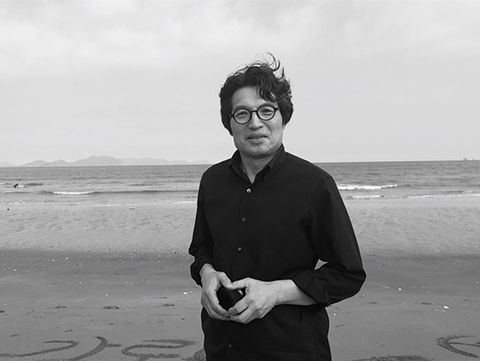
Jennis: You said that the flow of water is like the history of the earth. I also see many rocks in your works. Can I ask the meaning of the rocks?
Song Philyong: The waterfall embodies a variety of meanings. It can represent the wild flow of currents in the world, or it can stand for the spirit of uprightness, righteousness, and truth.
I am following the waterfalls’ essence: the sound of uprightness. And the rocks, standing firm against the waterfall, symbolize those who have lived on this land – strong rocks that stand tall, not washed away by the water.
Jennis: So, the rocks are like the power of the people. They are surrounded by the falling water, but still remain standing.
Song Philyong: Right, that is the idea I try to capture.
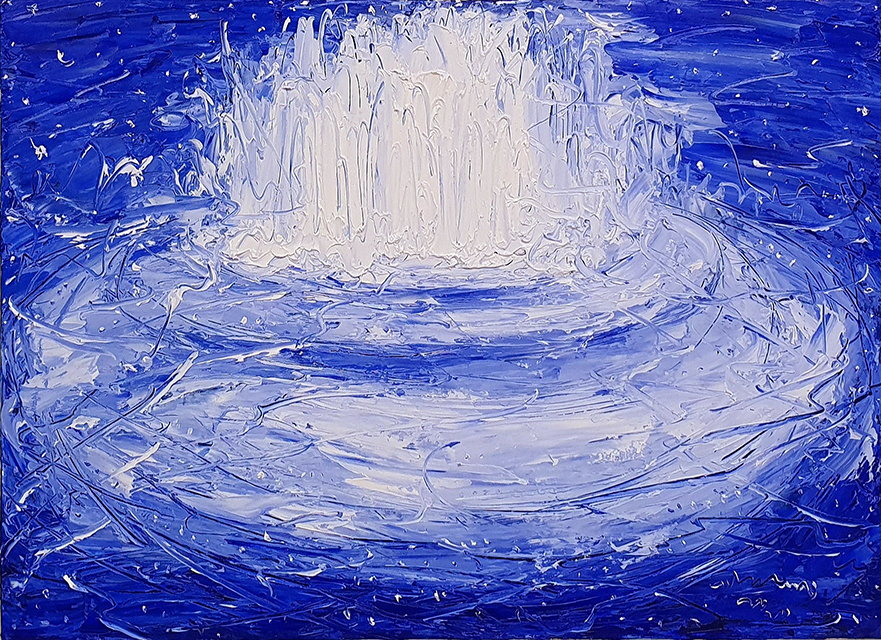
Jennis: I heard that you studied art education at Chonnam University in Gwangju and that you completed your master’s degree at Hongik University in Seoul. How was your school life?
Song Philyong: I entered Chonnam University in 1977, and when I was in my senior year, the May 18 Uprising occurred. As a citizen of Gwangju, I also went through the chaos abundant during that time. Continuing for ten years after May 18, 1980, I felt skeptical about my life, my painting, and the realities around me.
Jennis: I can guess how you felt. I lived in downtown Gwangju at that time in 1980. I can still hear the echoes of gunshots hitting buildings and the people shouting chants. I was too scared to go out to see, but my older sister saw a man getting shot when all he was doing was holding the national flag.
Song Philyong: Right. We cannot forget the tragedies. That is why I started to paint the history of the land. When I studied at Chonnam National University, I learned from Professor Lee Tae-ho. He helped me to open my eyes to see the history of this land.
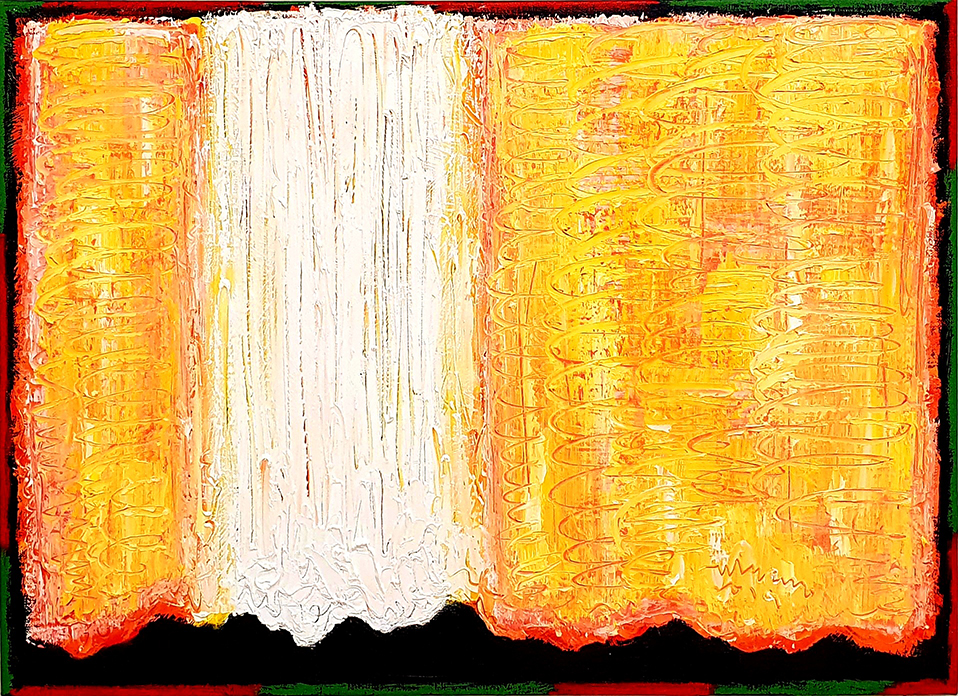
Jennis: Wow, I also learned from him. Professor Lee Tae-ho taught us the History of Korean Arts. He let us go to temples to sketch the old stone Buddhas there. I really enjoyed his class. I am glad we have memories of him in common. So, you traveled all over the country with him?
Song Philyong: Yes. It was during this period that I consolidated my fundamental reflections on the history of this land. Professor Lee and I traveled all around the country, and I came to feel the energy of the land as a result of those experiences. All the while, I wondered why innocent people had to die, and what new hope there was for us. Then I started to paint about what has happened to the people over the past century, from the Donghak Peasant Uprising to the May 18 Uprising.
Jennis: This 100-year history was indeed like a roaring waterfall. Within roughly the last century, we had the Donghak Peasant Uprising, the Japanese occupation, the March 1st Independence Movement, the Gwangju Students’ Independence Movement, the Korean War, liberation, the North–South division, the Jeju 4.3 Uprising, the Yeosu-Suncheon Incident, the April 19th Revolution, and the May 18 Uprising – so many things have happened. Have you captured all of them on canvas?
Song Philyong: Yes, I have painted those events on a 16.5-meter-long panorama as an epic of this land. The work is now kept as part of a collection at the Gwangju Museum of Art.

Jennis: I think an artist’s life is reflected in his or her works. What memorable childhood story do you have that may relate to your artistic life?
Song Philyong: I was born on the Goheung Peninsula on the coast south of Gwangju. I liked to draw from my youthful days. Sometimes I went out for sketching at the hermitage called Sudo-am at Un-am Mountain, or to the seaside near my house.
Jennis: Oh! I know that hermitage. My husband’s hometown is also close to Un-am Mountain, so I once went up the mountain with my first child when he was a baby. After driving up a steep and winding road, I met an elderly Buddhist monk who lived alone at the small temple. Sitting on the floor, we talked over tea. When he saw me comforting my child to get him to sleep, he said, “You remind me of my mother who would have raised me like you are raising your child. She must have died long ago. I left her in North Korea.” It is amazing that we both have memories of the same place, Sudo-am.
Song Philyong: I am glad you know my hometown. Right at the base of Un-am Mountain, there is Undae Village, which had the biggest kilns for Buncheong pottery during the Joseon Dynasty. Then, all of a sudden, the pottery kiln fires went out in the 16th century. People do not know the exact reason why, but a few years ago, the Buncheong Cultural Museum was built in the village.
Jennis: So, you grew up in the village, absorbing the remnants of traditional culture, with shards of pottery scattered here and there.
Song Philyong: Right. Buncheong pottery began to be made after Goryeo celadon. The method of making Buncheong pottery was easier than that of Goryeo celadon, which consisted of inlayed patterns. But Buncheong pottery also went through several stages. Starting first with dipping the dark clay pottery into white watery clay. Then, patterns were etched in with a sharp tool. Using this technique results in a really beautiful pattern. It is called the Johwa technique.
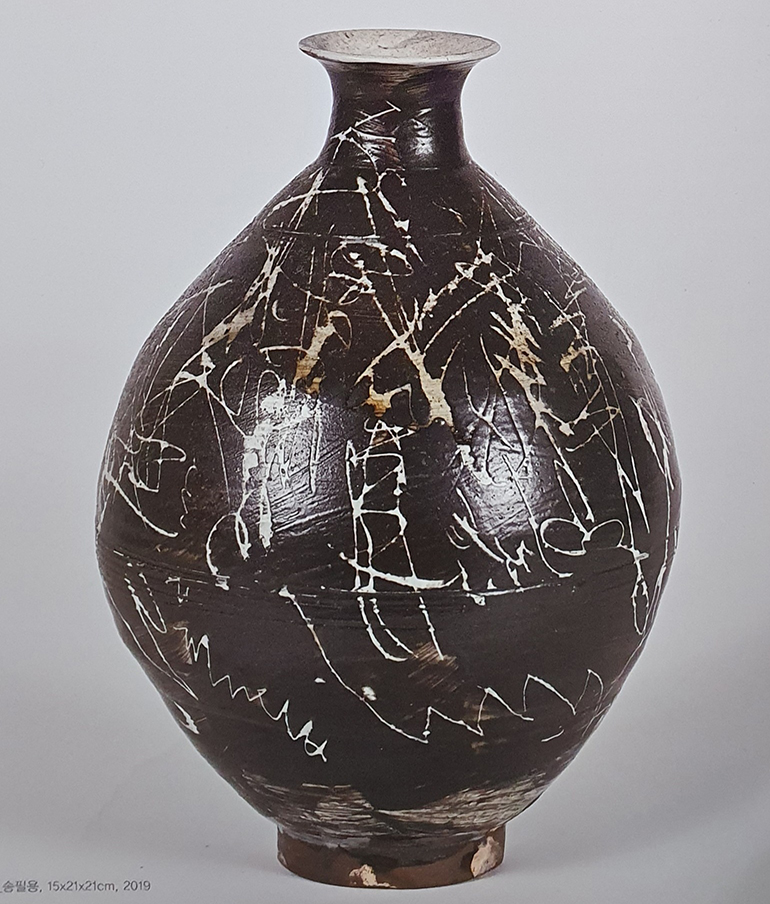
Jennis: So, the technique is more simplified than that of Goryeo celadon. I heard you used the Johwa technique on your paintings. Would you tell me how?
Song Philyong: I paint a base on the canvas, and when the paint dries, I coat it with diverse, deep colors. I express the history of this land through the layers of the base. Before the last layer dries, I draw waterfalls and rocks in powerful strokes with sharp tools, similar to what has been done with Buncheong pottery.
Jennis: Your paintings could be thought of in some regards as pottery but on flat canvases. I noticed your scraping skills in your works such as the Mt. Geumgang series. How do you paint Mt. Geumgang?
Song Philyong: Mt. Geumgang has been loved by many people and by a lot of artists since long ago. I was especially impressed by Gyeomjae Jeong Seon’s renderings. His paintings depicted the real landscape of Geumgang. The word “real” here means the “essence” of nature. He was called the “Saint of Art” in the Joseon Dynasty. I had always wanted to see the real Mt. Geumgang in North Korea and luckily, in 1998, Mt. Geumgang was opened to tourists from South Korea, so I was able to go see its beautiful scenery. Inspired in my own right, I painted it on my canvases in my own way.
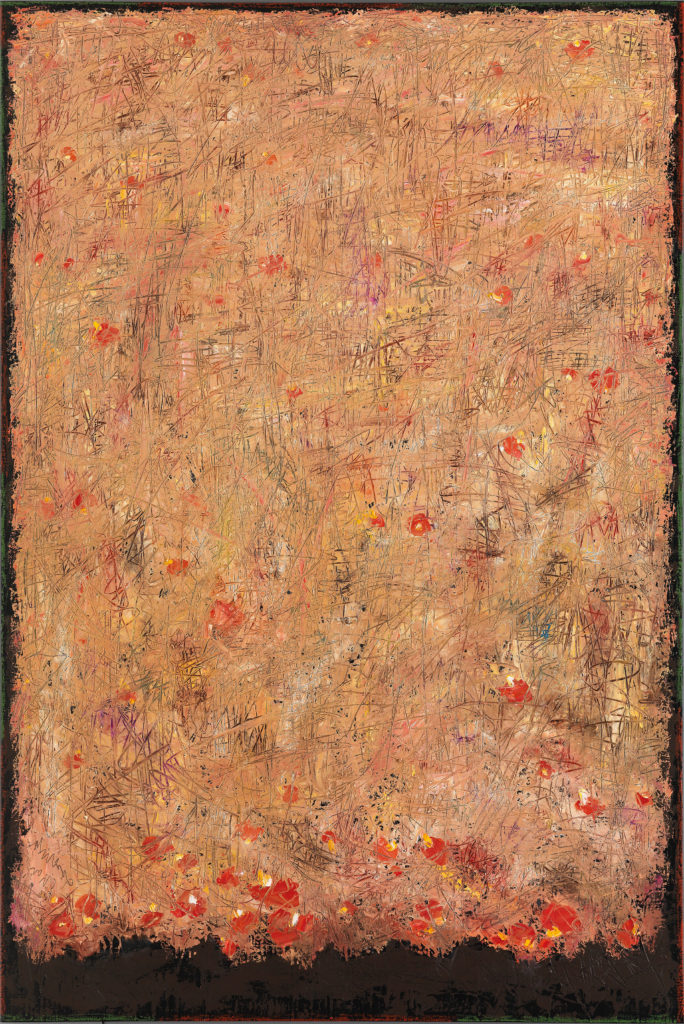
Jennis: I have never been to Mt. Geumgang. Was it not difficult to visit North Korea?
Song Philyong: Yes, it was. The barrier between the North and the South has been standing for almost 70 years. Once, President Kim Dae-jung’s Sunshine Policy led North Korea to open Mt. Geumgang for a few years from 1998. I was able to hike up the mountain as many as 18 times, but it is closed again.
Jennis: How lucky you were! What moved you to trek through the mountain so many times?
Song Philyong: Mt. Geumgang is famous for the unique shapes of its rocks. It is said that people can see the shapes of all the creatures in the world in the rock formations of Mt. Geumgang. It also has beautiful waterfalls and jade-colored ponds. I went there to find the real essence of its landscape.
Jennis: I regret very much having missed the chance to see it. I hope to be able to see Mt. Geumgang sometime soon.
Song Philyong: I hope I can, too.
Jennis: So, you painted Mt. Geumgang and held exhibitions in Seoul. I heard your Geumgang paintings are even hanging in the Blue House.
Song Philyong: To my honor, three of my paintings are in the Blue House. Several times my paintings have been used as the background for summit meetings with the heads of other nations.
Jennis: Wow, that is truly amazing. You have told us about the people and the land through paintings of water, waterfalls, rocks, and Mt. Geumgang. What do you think will be your next subject?
Song Philyong: I think I will continue painting waterfalls, capturing the essence of water. Waterfalls contain the sound of uprightness. I am drawing camellias these days, as well. What is unique about these flowers is that the petals of the camellia do not flutter to the ground one by one; the whole flower falls off at once. The abruptness of the flower’s falling without hesitation is like a waterfall, I think.
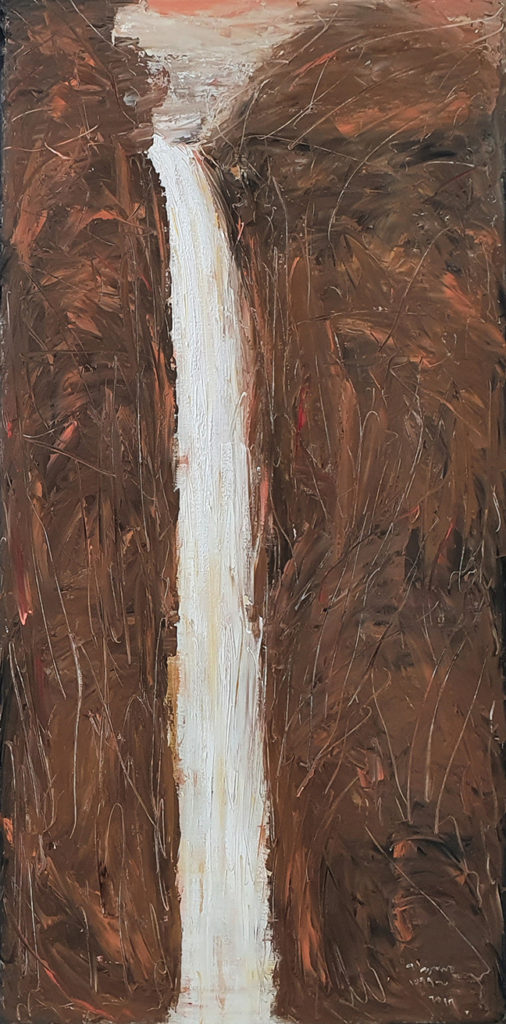
Jennis: People say that the camellia blooms three times: once on the camellia tree, once after falling on the ground, and finally, once more in our hearts. I am sure your camellias will bloom in our hearts, too. Thank you for your time, Mr. Song.
Major Individual Exhibitions
2016 Gyeomjae Jeongseon Art Museum, Seoul
2015 Gwangju Museum of Art, Gwangju
2012 Ewha Gallery, Seoul
2004 Hakgojae Gallery, Seoul
2002 Ewha Womans University, Seoul
2000 Hakgojae Gallery, Seoul
1995 Kumho Museum of Art, Seoul
Major Group Exhibitions
2015 Gyeonggi Museum of Art, Ansan
2014 Yi Eung-no Memorial Hall, Hongseong
2013 Gwangju National Museum, Gwangju
2012 Ilmin Museum of Art, Seoul
2010 Interalia, Seoul
2009 Gwangju National Museum, Gwangju
Main Collections
National Museum of Contemporary Art, Seoul Museum of Art, Gyeonggi Museum of Art, Jeonbuk Provincial Museum of Art, Gwangju Museum of Art, Kumho Museum of Art, Ilmin Museum of Art, and Gyeomjae Jeongseon Museum of Art, as well as the Blue House and Art Bank.
The Interviewer
Kang Jennis Hyunsook is a freelance English tutor and once-in-a-while interpreter. She likes taking photos of nature and reading books. Jennis enjoys meeting people in the arts, and she feels that the world is wide and full of so many wonderful people. Email: speer@naver.com.







